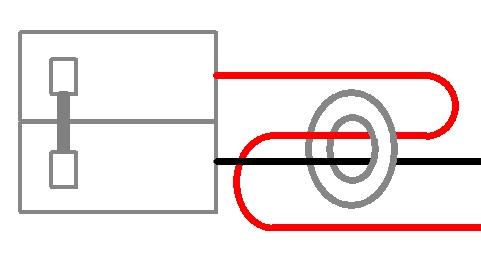Emporia Energy Community › Support Center › Hardware and Installation › 240V (double-wide breaker) installation?
- This topic has 14 replies, 10 voices, and was last updated 3 years, 2 months ago by
waterboyz.
-
AuthorPosts
-
-
nk42
MemberWhen monitoring a air conditioner unit or clothes dryer or electric range or other 240V circuit (double breaker) with the expansion pack, do I connect one sensor to each phase (both of the linked breakers) and somehow also link them in the app? Or do I only need to connect one of the phases and then assume the other phase is equally balanced (and double the calculated load)?
-
Jim @Emporia
Emporia StaffHello @nk42! Right now, there is no way to combine circuits in the app. This is a feature that we will be working on and releasing in the coming months. However, you can put one clamp on a single pole of the 240V circuit and use the circuit multiplier to double the usage of that sensor in the app.
-
cumanzor
MemberHi Jim! I’ve been wondering about this since I installed the Emporia in my house. So basically I ended up connecting TWO sensors to each pole of my 240v circuit as that was what the instructions implied. Then I saw the option to set a 2x multiplier in the app but really didn’t know what that meant.
So you are saying I can connect only one sensor to one pole of a 240v circuit and then set the multiplier to 2x and that should work? (The good thing about this is that it would free up sensors for other circuits).
Thanks!
Carlos
-
-
Marty @Emporia
Emporia StaffHello Carlos, you are correct! The whole idea of the multiplier was to free up additional sensors.
-
jc523
MemberYou may want to update the diagram in the installation manual, as it clearly shows a sensor being attached to each leg of a double breaker, under Step: 6.
-
-
cumanzor
MemberMarty, that’s fantastic news! Thanks!
-
dheatherly
MemberHopefully a quick easy question. Switched over from gen 1 to gen 2 so going through the sensor allocation again. Attached one sensor to one of the wires coming from a 240v breaker for my dryer. Noticed later the dryer was running but emporia wasn’t tracking the energy draw on that sensor. I then switched it to the other wire on that same breaker and all is good (using 2x multiplier). Why is that?
-
dheatherly
MemberAn added bit of info – when the dryer isn’t running my balance is around .200-.300. / second. When the dryer is running but not heating the balance drops to around .030/s. when the heating element kicked in (as evidenced by an increase in energy usage) the balance energy drops into negative territory (like around -.030/s). Is this a factor of accuracy error or is using a 2.0 multiplier on this (or some other 240v circuit) not ideal?
-
currentdraw
MemberI am also having problems with the dryer and I suspect the multiplier approach does nor work with dryers.
What I see is some high usage when normal drying, but 0kWh, when on energy saving, and I tapped only one wire.
So probably what happens is that in energy saving, it only uses the 120v from one half of the plug, which is not the one that I happened to tap.
I will try to tap the other one also, though it is hard since I have half breakers.
The multiplier approach seems to work fine with EV charger, probably since that one mostly draws symmetrically.
-
waterboyz
MemberMy plan for 220v circuits is to monitor each leg with its’ own CT. So, if my water heater generally has the same usage on both legs then I will remove one CT and use the multiplier on the other CT based on the usage. It may not be exactly 1.00 but close enough for Government work.
As to dryers. You will never be able to use just one CT on the circuit. The heating coil uses 220v. The motor and electronics use 110v. When a dryer goes into “anti-wrinkle” mode, only the 110v is used. Generally.
-
-
waterboyz
MemberPlayfair
Nice drawing.
I don’t think that would work. Our dryer was used for the first time under Emporia yesterday. Guessing 2 loads. Dryer Leg 1 used 3.194 and Dryer Leg 2 used 2.748. I’ve not looked at the electrical drawing of the dryer to see what is what….yet. Nor have I checked the usage during an extended anti-wrinkle mode.
-
currentdraw
MemberI think the drawing should work but usually 240 wires are thick and hard to bend.
-
jj613
MemberIf the 220V device has no neutral wire going into it you can rely on the sides being balanced and you can use one lead and 2X multiplier.
If it has a neutral you have to imagine it might not be balanced and experiment. I put two leads on my combo washer/dryer. I found that the second and minute data showed a reasonable amount of imbalance but the week/month energy consumption was within 2%, about a 1kWh per month difference on almost 40kWh usage. OTOH I have 16 sensors and 50 circuits so there are many things I’d rather be doing with that second sensor than precisely measuring that 2%.
-
waterboyz
Memberjj613 said:
“…I put two leads on my combo washer/dryer. I found that the second and minute data showed a reasonable amount of imbalance but the week/month energy consumption was within 2%, about a 1kWh per month difference on almost 40kWh usage. OTOH I have 16 sensors and 50 circuits so there are many things I’d rather be doing with that second sensor than precisely measuring that 2%.”
Yeah, I’ll probably do that as well but I’m in this for less than two weeks so I’m gathering data now.
-
-
AuthorPosts
- You must be logged in to reply to this topic.

